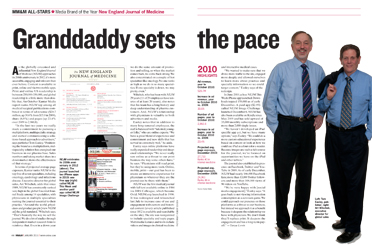AllStarsMediaBrand.pdfAs the globally esteemed and influential New England Journal of Medicine (NEJM) approaches its 200th anniversary in 2012, it’s more accessible, engaging and relevant than ever before. Content is available in print, online and via two mobile apps. Print and online US readership is between 250,000-350,000, and global readership is a little more than double that. An October Kantar Media report ranks NEJM top among all medical/surgical publications combined in terms of ad revenue ($20.7 million, up 30.6% from $15.9 in 2009), share (6.8%) and pages (up 23.4% over 2009 to 2,960.8).
“In the last two years we really made a commitment to pursuing a multiplatform, multispecialty strategy and started communicating a solutions-based approach to advertisers,” says publisher Tom Easley. “Positioning the brand as a multiplatform, multispecialty solution has energized our business in our pharma base. Sales numbers and taking market share in a down market shows the effectiveness of that strategy.”
In terms of projected average page exposure, Kantar ranks NEJM in the top five of seven specialties, including oncology, cardiology and infectious disease. Executive director for global sales, Art Wilschek, adds that since 1989, NEJM has consistently ranked very high in the global Essential Journal Study among 14 specialties, with physicians in multiple specialties naming the journal essential to their practice. “Around the world, physicians and product people [view NEJM as] the gold standard,” Wilschek says. “That’s basically the way we sell the journal. We do a lot of studies through independent market research firms to reinforce that. Even in a down year we do the same amount of promotion and selling, so when the market comes back, we come back strong. We also concentrated on a couple of hot specialties like oncology. No one ranks as high as we do in so many specialties. If one specialty is down, we stay pretty even.”
Wilschek, who has been with NEJM 29 years (11 of 29 employees have tenures of at least 20 years), also notes that his team has a long history and deep understanding of pharma customers. And, NEJM‘s relationship with physicians is valuable to both advertisers and media.
Easley notes that in addition to many long-tenured employees, the staff is balanced with “talented, younger folks,” who are online experts. “We have a great blend of experience and commitment and new skills that has served us extremely well,” he adds.
Easley says online platforms have really expanded readership and deepened relationships. “We never really saw online as a threat to our print business the way some others have,” he says. “Physicians still read print, but they’re using more tools. Online, mobile, print—our goal has been to create an immersive experience for physicians so wherever they are the journal can be there with them.”
NEJM was the first medical journal with full text available online in 1984 via BRS Colleague, which became Ovid. NEJM.org launched in 1996. It was redesigned and relaunched last July to increase ease of use and engagement with current and historical content (every article published since 1812 is available and searchable on the site). The site was reorganized to include specialty and topic pages. Multimedia features and tools include videos and images in clinical medicine and interactive medical cases.
“We wanted to make sure that we drove more traffic to the site, engaged more deeply and allowed ourselves to learn more about practice and specialty information so we could target content,” Easley says of the redesign.
In June 2010, a free NEJM This Week iPhone app launched. Downloads topped 158,000 as of early December. A paid app ($2.99) called NEJM Image Challenge launched December 6. NEJM has also been available on Kindle since May 2009 and has sold upward of 35,000 monthly subscriptions and more than 2,000 single issues.
“We haven’t developed an iPad specific app yet, but we have many options,” says Easley. “We could do a more custom educational experience based on content or look at how we could use iPad as a four color e-reader. Because images are such a rich source for the journal, we’re focused on opportunities we have on the iPad and other tablets.”
The journal also established its presence on Facebook, Twitter and YouTube in 2009. As of early December, NEJM had nearly 166,000 Facebook fans; more than 13,000 Twitter followers; and more than 108,000 views of 96 videos on YouTube.
“We’re very happy with [social media engagement],” Easley says. “It goes back to not viewing information consumption as a zero sum game. We could approach our presence on those platforms as a threat to our business, but instead we approach it as a benefit because it deepens the relationship we have with physicians. We don’t think they’ll replace print. It deepens the engagement and has a long-term payoff.”
From the January 01, 2011 Issue of MM+M - Medical Marketing and Media








